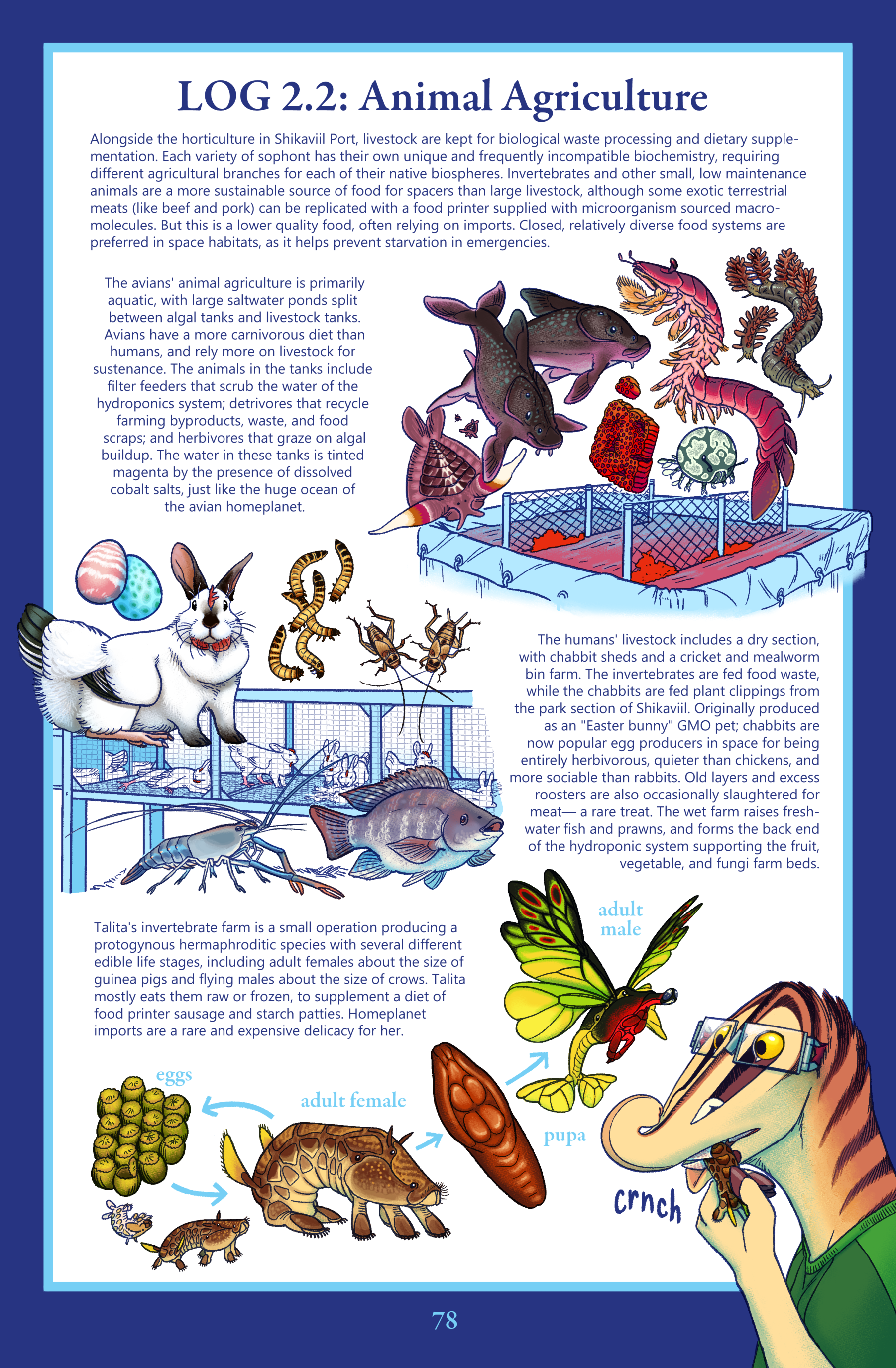This page was a lot of fun. If only my job was just drawing context-free animals floating on a white background.
Final reminder to get questions in for the inter-chapter character AMA.
Transcript
LOG 2.2 Animal Agriculture
Caption: Alongside the horticulture in Shikaviil Port, livestock are kept for biological waste processing and dietary supplementation. Each variety of sophont has their own unique and frequently incompatible biochemistry, requiring different agricultural branches for each of their native biospheres. Invertebrates and other small, low maintenance animals are a more sustainable source of food for spacers than large livestock, although some exotic terrestrial meats (like beef and pork) can be replicated with a food printer supplied with microorganism sourced macromolecules. But this is a lower quality food, often relying on imports. Closed, relatively diverse food systems are preferred in space habitats, as it helps prevent starvation in emergencies.
Avian Livestock Animals
Background Image: A tarp-lined pool of tinted water has suspended nets vertically submerged in it with stuff growing on them.
- a fish-like creature with six eyes and horizontal caudal fin
- a chiton-like animal with a seaslug face, fins, and greatly enlarged antennae
- a red colonial tunicate-like honeycomb crust
- an extremely round crab-like thing
- a crustacean-like animal with a long segmented eel-like body
- a polychaete worm-like animal with body segments that transition into new individual worms who break off
Caption: The avians' animal agriculture is primarily aquatic, with large saltwater ponds split between algal tanks and livestock tanks. Avians have a more carnivorous diet than humans, and rely more on livestock for sustenance. The animals in the tanks include filter feeders that scrub the water of the hydroponics system; detrivores that recycle farming byproducts, waste, and food scraps; and herbivores that graze on algal buildup. The water in these tanks is tinted magenta by the presence of dissolved cobalt salts, just like the huge ocean of the avian homeplanet.
Human Livestock Animals
Background Image: A long hutch full of chabbits with nesting boxes at the end.
- a chabbit, a hexapodal GMO with bird-like hindlimbs, winged midlimbs, and rabbit-like forelimbs. The rear torso and pelvis are feathered, while the front of the animal resembles a typical rabbit with a chicken comb and wattles. The individual shown is a commercial breed with black and white pointed coloration.
- chabbit eggs, two varieties shown: a pink stripe egg and blue egg with green spots. Their markings are distinctive but naturalistic.
- mealworms (Tenebrio molitor var. stelladomesticus)
- crickets (Gryllus assimilis var. stelladomesticus)
- freshwater prawn (Macrobrachium rosenbergii)
- freshwater fish (Sarotherodon galilaeus)
Caption: The humans' livestock includes a dry section, with chabbit sheds and a cricket and mealworm bin farm. The invertebrates are fed food waste, while the chabbits are fed plant clippings from the park section of Shikaviil. Originally produced as an "Easter bunny" GMO pet; chabbits are now popular egg producers in space for being entirely herbivorous, quieter than chickens, and more sociable than rabbits. Old layers and excess roosters are also occasionally slaughtered for
meat— a rare treat. The wet farm raises freshwater fish and prawns, and forms the back end of the hydroponic system supporting the fruit, vegetable, and fungi farm beds.
Centaur Livestock Animal
Image: A lifecycle of an alien invertebrate is shown. They have jar-like eggs with ridged sides and a circular "lid" which pops open when hatching. The juveniles look like smaller versions of the adult female, who is a strange hexapod with a mottled brown, partly exoskeletal body with six tiny eyes and an appearance somewhere in between a caterpillar, and guinea pig, and a sea cucumber. The female pupates and then becomes an adult male. The male is radically different with jointed butterfly like wings, a slim shrimp-like body, a proboscis with large compound eyes, and bright red, yellow, green, and black coloration.
Caption: Talita's invertebrate farm is a small operation producing a protogynous hermaphroditic species with several different edible life stages, including adult females about the size of guinea pigs and flying males about the size of crows. Talita mostly eats them raw or frozen, to supplement a diet of food printer sausage and starch patties. Homeplanet imports are a rare and expensive delicacy for her.
Image: Talita bites into a whole adult female bug.
SFX: crnch








36 thoughts on “Runaway to the Stars: Page 78”
Anglure
I could stare at this page forever. I love poring over little alien lifeforms
dokki
So mad that I can’t eat those avian fish without getting heavy metal poisoning.
Amargarrex
I would have liked to try alien food
Trees
Personal favourite: Perfectly spherical Avian crab with the furious expression.
Round and angry about it.
Havlock
With how same-y and low quality Talita’s diet is, it makes me wonder if there are spices or seasonings from the Centaur homeworld she could have imported to add some extra flavor to her meals. I figure such things would take up less shipping mass and volume than food from there, and thus be at least somewhat cheaper.
Redacted
I can’t help but wonder if Talita is gonna be able to fit her invertebrate farm on the Runaway.
Tyrone the Miner
“CRNCH”…And I just turned vegan!
Redacted
Man I wish Chabbits were real I want one
Liza
Me too! I’m pretty sure if I lived in this setting I’d either be a xenolinguist like Gillie and Idrisah or running a shelter for abandoned GMO pets.
audible_smiles
I’m starting a countdown to when we get fanfiction that’s just about Talita getting to eat food that is good…
Redacted
Talita finally gets to have her “That one Ratatouille scene” moment.
hessian
i really love these log pages. animal pictures with simple diagrams and descriptions are so nostalgic, they remind me of all those DK eyewitness books i’d read as a kid :]
Redacted
Dude if Jay made a book like that for the Rtts universe I’d buy it instantly
anon y mouse
Super cool! It also suggests that shrimp and insect allergies would be a detriment for spacers, since those are major sources of protein.
wingedhorror
I assume (with their level of gene therapy and medical technology) that such hypersensitive immune responses can be mitigated. I hope!
Trees
Hopefully.
As much as I find the GMO baby stuff moderately horrifying I also hope the gene science of the RttS future has been able to do something about humanity’s achy, poorly designed spines. Here’s to a future without near-inevitable back pain!
leif
shellfish is my favorite genre of food and i high key want to eat all of the alien bugs featured here (even though i know it would make me awfully sick)
Gar G
Love it. I love it so much. I love worldbuilding details like this and seeing exotic alien fauna. This was a real treat for me, no pun intended!
Apollo235
She finally got to eat a bug!
https://www.tumblr.com/jayrockin/668264116406845440/douglas-do-you-have-any-funny-stories-from-when?source=share
Fallingfeather
I love how these make use of the organic waste (plant clippings, parts of vegetables people won’t eat, poop, etc.) and cycle it back into the sort of… “food web” so no calories are lost. Very efficient! Do people usually eat the crickets and mealworms as-is sort of, or are they ground down and used as a protein supplement for otherwise normal vegetarian dishes?
Jay Eaton
The average spacer culture is much less squeamish about eating whole insects than most people today. Insect flours aren’t unheard of, but yeast-based protein powders are more commonly manufactured. (Yeast and algae flours are the typical backbones of spacer diets…)
Eldermage1
I absolutely love food and agriculture based worldbuilding, aspects far too often neglected. To see it so well thought out, especially in a science fiction setting, makes me so very happy!
hal9000
those butterfly shrimp are so cute i want to eat one too now … looks like the kinda bug that would be excellent steamed in a rich creamy sauce
poor Talita though, living entirely off the equivalent of cat food and crickets must get so horrendously boring. “Ooh, what’s for dinner tonight? The exact same thing I had for breakfast and lunch? Yay!”
i would like to take her to a planet with more centaur trade or even her home planet for a culinary holiday, she deserves it :<
Mothman
Man this page really shows how limited Talita’s diet is in her situation. Food printer or one kind of bug. No wonder she has a weird relationship with food!
I wonder how she would feel if she got to experience living with the variety and quality of foods on her home planet, even just for a little while.
Paroxysmall
I love the carcinized orb
Paroxysmall
Whatever Cheevwut had eaten when we saw their room, were those imported? Or just something from agriculture
Pathfinder
*Crunch*
Joysweeper
I sense that there will be comments saying that jay’s worldbuilding should have universal veganism and anything else doesn’t make sense again.
Personally I feel like mute chickens would be easier to engineer than rabbit perytons, but chabbits are interesting and it makes sense as a part of a setting where humans have gotten just intensively comfortable with making GMOs. It shows the degree of that comfort, that there’s a whole novel, strikingly different species that can be common livestock, and a way that they’re more removed from humans of today.
Fallingfeather
Tbf mute chickens probably would be easier, but it sounds like these were critters designed for an “entertainment niche” first and people went “wait that’s actually really useful” after the fact. A happy accident!!!
Ardzruni
I like to imagine that some highly-overqualified PhD geneticist working at a trendy GMO lab in the 2100s had this dumb meme project dumped on their desk, but they just cracked their knuckles and said “if corporate wants a bunny-chicken then by God they’re gonna get a PROPER bunny-chicken.”
Bear-on-a-tricycle
I absolutely love your world building. It’s fantastic! Does Talita’s invertebrates have a species name? Based on the adult male stage, they could easily earn the nickname butterfly shrimp.
Jay Eaton
I haven’t given them an English name (or any name…), butterfly shrimp works well enough!
0xabad1dea
oh my gods do chabbits lay pre-dyed eggs
Jay Eaton
Different breeds will have a signature egg color and pattern 🙂
Amanda/OwlBear
the centaur inverts are so cute, it’s interesting to see how the different bits of the juvenile/female are expressed in the male, I assume the little flappy bits at the creature’s back become the wings, I wonder what ecological niche they (or their wild type ancestor) filed back on the centaur homeplanet, what do they eat?
kinda sad that Talita only has one species of livestock animal, but at least she has access to something other than printed food
Zuorai
I’m so obsessed with the avian invertebrates, especially the worms and the honeycomb filter feeder. All so very interesting